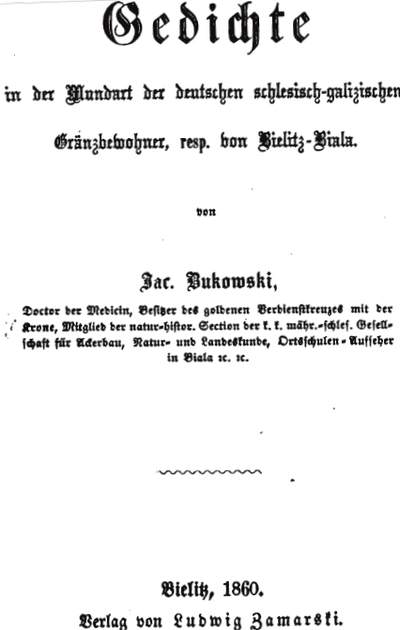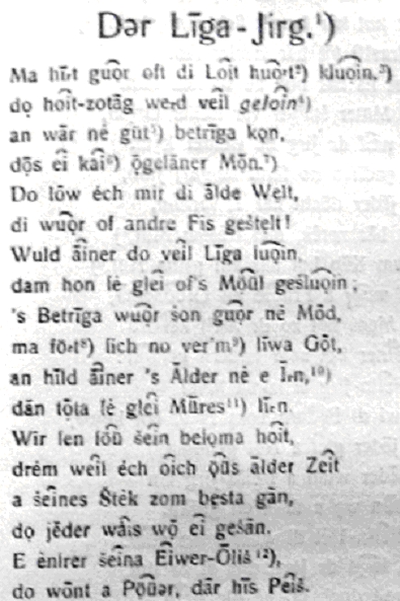Hałcnovian and Bielsko-Biała enclave
Spelling systems
Up until the II World War, it was primarily the German alphabet that was employed to write the majority of texts written in the Bielsko German dialects.The only post-WW2 texts written in these language varieties are the non-academic writings of Karl Olma in which he used a modified version of the German alphabet. It was not, however, the standard German font. Avoiding the standard font was a widespread tendency after the II World War.
Hand-written and printed fraktur (see: www.jewishgen.org/jri-pl/translit.htm).

The front page of Jacob Bukowski's book (1860
 Bukowski 1860 / komentarz/comment /
Bukowski 1860 / komentarz/comment / Bukowski, Jacob 1860. Gedichte in der Mundart der deutschen schlesisch-galizischen Gränzbewohner resp. von Bielitz-Biala. Bielitz: Zamarski. [przedruk w: Wagner 1935: 1-190].
 )
)Additionally, there are three publications in which a phonetic transcription has been used: the poem Liega-Jirg (Jurek the Liar) by Friedrich Bock (1916a
 Bock 1916a / komentarz/comment /
Bock 1916a / komentarz/comment / Bock Friedrich 1916b. Der Liega-Jirg. Gedicht in der Bielitzer Mundart. Bielitz: Friedrich Bock. [przedruk w: Wagner 1936: 222-230].
 ), a fragment of the Óf jer wełt poem by Florian Biesik transcribed by Tomasz Wicherkiewicz (2003: 467-471
), a fragment of the Óf jer wełt poem by Florian Biesik transcribed by Tomasz Wicherkiewicz (2003: 467-471 Wicherkiewicz 2003 / komentarz/comment /
Wicherkiewicz 2003 / komentarz/comment / Wicherkiewicz, Tomasz 2003.The Making of a Language. The Case of the Idiom of Wilamowice, Southern Poland. Berlin-New York: Mouton de Gruyter.
 ) as well as the transcription of Wenker's example sentences conducted in Wilamowice (the sentences can be browsed on the following webpage: http://www.diwa.info/Wenkerbogen/Bogen.aspx?ID=66998).
) as well as the transcription of Wenker's example sentences conducted in Wilamowice (the sentences can be browsed on the following webpage: http://www.diwa.info/Wenkerbogen/Bogen.aspx?ID=66998).
The first page of the Der Liga-Jirg poem written in phonetic script according to the recording made in 1916 in Stare Bielsko/Altbielitz (see: Bock 1916b: 225
 Bock 1916b / komentarz/comment /
Bock 1916b / komentarz/comment / Bock Friedrich 1916b. Der Liega-Jirg. Gedicht in der Bielitzer Mundart. Bielitz: Friedrich Bock. [przedruk w: Wagner 1936: 222-230].
 ).
).ISO Code
no separate code for the Bielitz-Biala Sprachinsel or Hałcnovian
possible code: hlc
possible code: hlc
- Biogram
- Pieśń Olmy 1
- Pieśń Olmy 2
- Pieśn Olmy 3
- Pieśń Olmy 4
- Składanka pieśni Olmy
- Składanka pieśni Olmy 2
- Pieśn Olmy 5
- Modlitwa dziecięca
- Bajka o Wietrze Północnym i Słońcu
- Opowiadanie o weselu
- Opowiadanie o głównych zajęciach hałcnowian przed wojną
- Opowiadanie/rozmowa o kościele hałcnowskim
- Dialog o strojach hałcnowskich
- Rozmowa o hałcnowiankach
- Krótki wierszyk
- Dwa dowcipy hałcnowskie
- Opowiadanie o ostatnich tygodniach
- Pieśń Olmy w wykonaniu męskim
- Rozmowa o życiu dzieci przed wojną
- Rozmowa o Świętach Bożego Narodzenia
- Rozmowa o dzieciństwie
- Zdania Wenkera
- Żart o wilamowianach (video)
- Opowiadanie o zalotach
- Pieśń hałcnowska - wersja video
- Opowiadanie o odpuście
- Rozmowa o jedzeniu (video)
- Dokumenty hałcnowskie sprzed wieków
- Informatorzy
- Zbiór pieśni hałcnowskich
- Stroje hałcnowskie
- Rozmowa o wilamowianach (doświadczenia z dzieciństwa)
- Słowniczek polsko-hałcnowski
- Lista Swadesha
- Arkusz Wenkera
- Zasady zapisu
- Słowniczek bielski
- Schatzla, eta komma wir [tekst]
- Alzner Hymne [tekst]
- Rozmowa o wsi przed wojną
- Prezentacja z wystąpienia na KNG
- Prezentacja z wystąpienia na SNBHJ w Toruniu
- Prezentacja z wystąpienia w Kamieniu Śląskim
- Prezentacja z wystąpienia na OKH w Poznaniu
- Bock 1916b
- Weiser 1937
- Waniek 1897
- Olma 1983
- Polak 2012
- Chorąży i Chorąży 2010b
- Putek 1938
- Chorąży i Chorąży 2010c
- Panic 2010
- Panic 2002
- Hanslik 1938
- Kuhn 1981
- Polak 2010
- Hanslik 1908
- Meier & Meier 1979
- Zöllner 1988
- Chodera i Kubica 1984
- Urban 2001
- Janoszek i Zmełty 2004
- Mickler 1938
- Wagner 1937a
- Wagner 1937b
- Wagner 1938
- Gusinde 1911
- Spyra 2010
- przyp01
- przyp02
- przyp03
- przyp04
- przyp05
- przyp06
- przyp07
- przyp08
- przyp09
- przyp10
- przyp11
- przyp12
- przyp13
- przyp14
- przyp15
- przyp16
- Wiadomości na temat zaimków hałcnowskich
- Odmiana wybranych czasowników hałcnowskich
- Wiadomości na temat rodzajników hałcnowskich
- Zasady transkrypcji nagrań hałcnowskich
- Skrócony opis fonetyki/fonologii hałcnowskiej
- osoby z Hałcnowa,Bielska,Białej zmarłe w Oświęcimi
- zagrożenie języków / language endangerment
- Mapa bielsko-bialskiej wyspy językowej
- Arkusz Wenkera z DiWA
- fotografia pary z Hałcnowa w Wilamowicach
- akt małżeństwa
- Dworzec kolejowy w Bielsku
- Księstwo cieszyńskie w roku 1746
- strona tytułowa Bukowski 1860
- Panorama Bielska
- Kościół ewangelicki pw. Zbawiciela w Bielsku
- Pisana i drukowana fraktura
- Plac teatralny w Bielsku
- Rynek w Bielsku
- Bielsko-bialska wyspa - siatka przedwojenna
- Bielsko-bialska wyspa - siatka współczesna
- Śląsk austriacki
- Andreas Olma w stroju ludowym
- Bielskie stroje ludowe
- Baltazar Damek
- Wnętrze fabryki Johanna Vogta
- Zapis wiersza Der Liga-Jirg
- Początkowe wersy spektaklu Ein Bielitzer ...
- Kolonizacja niemiecka w średniowieczu
- Bielsko-bialska na Mapie Brockhausa
- Bielska wyspa na tle innych dialektów śląskich
- Spis mieszkańców Hałcnowa 1943/1944
- Para hałcnowska w stroju weselnym
- Poświadczenie obywatelstwa z roku 1905
- Książka "Heimat Alzen" - okładka
- Dawny kościół hałcnowski
- Niemiecka pocztówka z Hałcnowa
- Widok na Hałcnów
- Dzisiejszy kościół hałcnowski
- Widok na Hałcnów z lotu ptaka
- Samogłoski hałcnowskie
- Hałcnovian monophtong vowels